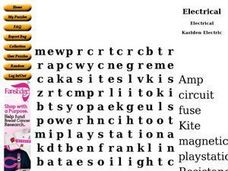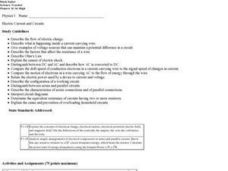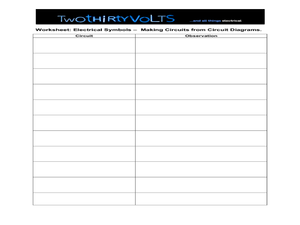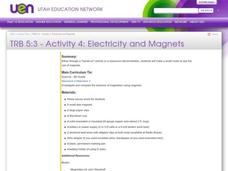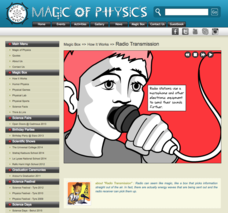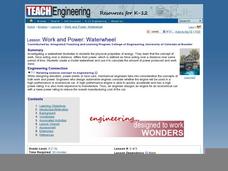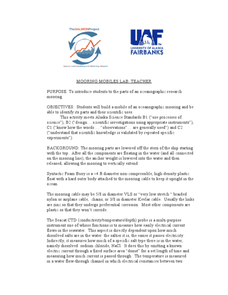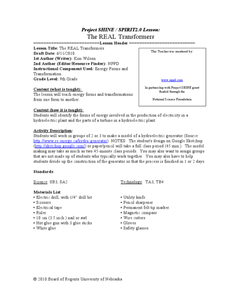Curated OER
Electrical
In this electrical worksheet, students identify and locate vocabulary words in a word search that are related to electricity. There are 27 words in the puzzle.
Curated OER
On The Move
Fourth graders solve basic mathematical problems. They identify and apply key terms and equations relative to physical science. They discuss how train engines use fuel to move a generator, which creates electrical current that moves...
Curated OER
Exploring Magnetism and Electricity
Students explore Faraday's Law. In this electromagnetism lesson, students investigate Michael Faraday. Students discover the history of the electromagnet. Students examine the parts of an electromagnet.
Curated OER
Electric Current and Circuits
Compare the drift speed of conduction electrons in a current-carrying wire to the signal speed of changes in current. They also distinguish between DC and AC and describe how AC is converted to DC.
Curated OER
Electrical Symbols - Making Circuits from Circuit Diagrams
Students draw different electrical circuit symbols. In this electricity lesson, students construct simple circuits based on circuit diagrams. They share their findings to class.
Curated OER
Focusing Event to Electricity
Students explain how electrical charges behave. In this electricity lesson, students determine how far away lightning is when it strikes. They research how fabric softener reduces static electricity and share their findings in class.
Curated OER
Electricity and Magnets
Fifth graders find examples of magnets in or around their homes and make a list. They discover that some motors use magnets and make a simple motor using magnets, a battery and copper wire. They add to their magnet list.
Curated OER
Science:Effects of Weathering
Seventh graders take an outdoor observation walk around the campus and take soil samples. Working in groups , they conduct experiments with rocks and soil that demonstrate the effects of different types of erosion.
Curated OER
Integrating Physics-Atomic Fingerprints
In this atomic fingerprint instructional activity, students read about the Bohr model and electrons changing energy levels and emitting energy. They answer questions about the atomic spectrum and the fingerprints for specific atoms.
It's About Time
Force Fields
Young scholars investigate both bar and horseshoe magnets. They explore force fields with a compass and iron fillings before making an electromagnet. This is the first in a series of nine lessons.
University of Colorado
The Jovian Basketball Hoop
Can you listen to Jupiter on a simple radio? Turns out the answer is yes! The resource instructs scholars to build a simple radio to pick up the radio waves created when the charged particles from the sun hit Jupiter's magnetic...
Wind Wise Education
What is the Cost of Inefficiency?
What does it cost to keep the lights on? Through a hands-on activity, class members use a watt meter and determine the amount of energy different types of light bulbs use. The class then determines the financial and environmental...
Magic of Physics
Franklin's Lab
Get energized! Circuitry scholars follow the path of energy from its beginnings as a fossil fuel all the way to bulbs and batteries using an interesting interactive. Groups or individuals help Ben Franklin discover how to convert and...
Magic of Physics
Radio Transmission
Radio waves are all around us! How do they transmit sound? Using an interactive, scholars examine how songs travel through the air. The resource explains the process from the radio station, to signal towers, to the radio unit. A look at...
Curated OER
Conductors and Insulators
Fifth graders explore conductors and insulators. In this science lesson plan, 5th graders act as electrons moving through a wire. Students break into groups representing conductors and insulators and explore how they work with electrons.
Curated OER
Work and Power: Waterwheel
Pupils investigate a waterwheel and the physical properties of energy. In this waterwheel lesson students create a model waterwheel and calculate the amount of power produced.
Curated OER
Mooring Mobiles Lab
Oceanography experts use candy to construct a model of a bio-physical mooring that would test a variety of factors. Each piece of equipment to be included on the mooring is described within the write-up. As pupils gather the candies for...
Mr. E. Science
Magnetism and Electromagnetism
The biggest magnet in the world is at the Los Alamos National Laboratory in New Mexico and can reach 100 tesla. By comparison, magnets that lift cars are about two tesla. The 11th presentation in this series covers magnetism,...
Curated OER
Urban Heat Islands: An Introduction to Energy Transfer and Transformation
Elementary school physical scientists explore kinetic mechanical energy by dropping a golf ball on different surfaces. They discuss how human made materials might react to light differently from nature made materials. This lesson plan...
Curated OER
Group 16, The Oxygen Group
The trends in group 16 and the characteristic behavior of the elements involved are listed here. Their properties also help support their function. Explanations of the atomic structure and valence electron number are not included. Since...
Curated OER
Water and Ice
Students examine water. In this chemistry lesson, student examine the physical properties of water and how it changes from a liquid to a solid or a gas. This lesson contains links to a second and third complimentary lesson on...
Curated OER
Is That Icebox Green?
Seventh graders create a timeline of the development of electrical appliances. In this physics lesson plan, 7th graders explore energy consumption over the past 90 years. They create a poster about their chosen electrical device...
Curated OER
Walk a Mile for a Burger?
Students are introduced to the pedometer, and use this tool to associate physical activity (physical energy) with calories burned (chemical energy). They comprehend the making and burning of energy.
Curated OER
The REAL Transformers
Ninth graders create a model of a hydroelectric generator. In this physics lesson, 9th graders discuss how energy can be transformed from one form to another. They make a flow chart for different energy generating plants.


